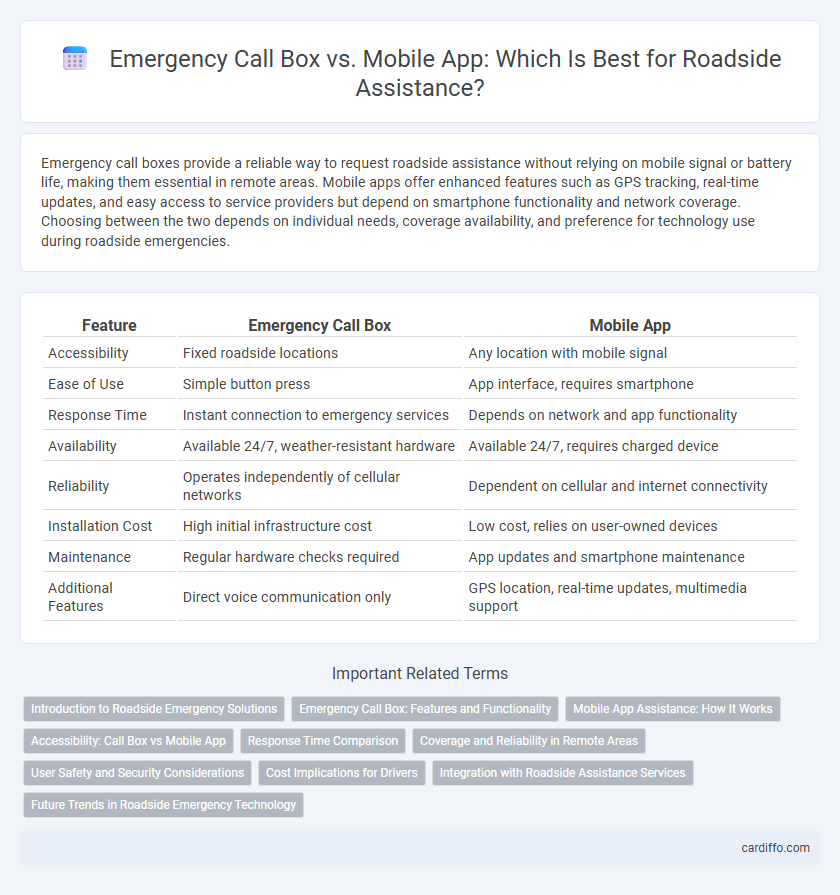Emergency call boxes provide a reliable way to request roadside assistance without relying on mobile signal or battery life, making them essential in remote areas. Mobile apps offer enhanced features such as GPS tracking, real-time updates, and easy access to service providers but depend on smartphone functionality and network coverage. Choosing between the two depends on individual needs, coverage availability, and preference for technology use during roadside emergencies.
Table of Comparison
| Feature | Emergency Call Box | Mobile App |
|---|---|---|
| Accessibility | Fixed roadside locations | Any location with mobile signal |
| Ease of Use | Simple button press | App interface, requires smartphone |
| Response Time | Instant connection to emergency services | Depends on network and app functionality |
| Availability | Available 24/7, weather-resistant hardware | Available 24/7, requires charged device |
| Reliability | Operates independently of cellular networks | Dependent on cellular and internet connectivity |
| Installation Cost | High initial infrastructure cost | Low cost, relies on user-owned devices |
| Maintenance | Regular hardware checks required | App updates and smartphone maintenance |
| Additional Features | Direct voice communication only | GPS location, real-time updates, multimedia support |
Introduction to Roadside Emergency Solutions
Roadside emergency solutions encompass a range of options including Emergency Call Boxes and mobile applications designed to provide rapid assistance during vehicle breakdowns or accidents. Emergency Call Boxes offer a reliable, fixed-point communication system that functions even in areas with poor mobile network coverage. Mobile apps complement these systems by enabling instant location sharing and direct contact with roadside assistance services through ubiquitous smartphone technology.
Emergency Call Box: Features and Functionality
Emergency Call Boxes provide a reliable, fixed-location communication system specifically designed for roadside emergencies, equipped with direct lines to emergency services for immediate assistance. These call boxes often feature high-visibility designs, weather-resistant materials, and automated location tracking to ensure rapid response in critical situations. Unlike mobile apps, they function independently of cellular networks or smartphone batteries, offering a fail-safe option for users in areas with poor reception or technological limitations.
Mobile App Assistance: How It Works
Mobile app assistance for roadside emergencies leverages GPS technology to pinpoint the user's exact location and enables direct communication with dispatchers for rapid help. Users can request towing, tire changes, fuel delivery, or mechanical assistance through intuitive interfaces, often supported by real-time tracking and status updates. Integration with vehicle diagnostics and service history enhances response accuracy and speeds up roadside assistance delivery.
Accessibility: Call Box vs Mobile App
Emergency call boxes provide immediate, location-specific access for roadside assistance without relying on cellular signals or smartphones, making them reliable in remote or low-coverage areas. Mobile apps offer enhanced accessibility through GPS integration, real-time tracking, and additional features like route sharing and service customization, but require a charged device and network connectivity. Both options complement each other by covering different accessibility needs--call boxes serve as a universal fallback, while mobile apps provide convenient, feature-rich assistance for tech-savvy users.
Response Time Comparison
Emergency call boxes typically provide faster response times due to direct, immediate connection to roadside assistance centers, bypassing delays caused by mobile network issues or app processing. Mobile apps, while offering detailed location sharing and additional services, may experience slower response times depending on signal strength, phone battery life, and user interaction speed. Studies show that emergency call boxes reduce average responder arrival time by up to 30% compared to mobile app requests in remote or low-signal areas.
Coverage and Reliability in Remote Areas
Emergency Call Boxes provide consistent coverage and reliable connectivity in remote areas where mobile networks may be sparse or nonexistent, ensuring immediate access to help during roadside emergencies. Mobile apps depend heavily on cellular signals, which can be unreliable or completely absent in isolated locations, potentially delaying emergency response. The fixed infrastructure of call boxes offers a dependable alternative to mobile apps, enhancing safety and response time along rural and remote roadways.
User Safety and Security Considerations
Emergency call boxes provide a reliable, fixed-location option for roadside assistance, critical in areas with poor mobile network coverage or for users without smartphones, ensuring immediate access to help. Mobile apps offer enhanced features such as real-time location tracking, direct communication with emergency services, and integration with vehicle diagnostics, improving response accuracy and user safety. Choosing between emergency call boxes and mobile apps depends on factors like accessibility, network availability, and user preferences for secure, timely assistance during roadside emergencies.
Cost Implications for Drivers
Emergency Call Boxes typically incur installation and maintenance costs funded by municipalities or highway agencies, resulting in no direct expense for drivers. Mobile apps for roadside assistance often require data usage fees and may involve subscription charges, impacting drivers financially over time. Evaluating cost implications, drivers benefit from the no-cost access provided by call boxes, while app users face ongoing expenses linked to app usage and connectivity.
Integration with Roadside Assistance Services
Emergency Call Boxes offer direct, reliable communication for roadside assistance without depending on cellular networks, ensuring help is accessible even in low-signal areas. Mobile Apps integrate GPS tracking and real-time service updates, enhancing coordination and response times by connecting users swiftly to roadside assistance providers. Combining both systems improves overall safety by providing multiple, complementary methods to request timely roadside help.
Future Trends in Roadside Emergency Technology
Emergency call boxes remain critical for immediate assistance in areas with poor cellular coverage, ensuring reliable communication during roadside emergencies. Mobile apps are rapidly evolving to integrate AI-driven diagnostics, real-time location tracking, and automated incident reporting, enhancing response efficiency. Future trends predict a hybrid approach, combining physical call boxes with advanced app functionalities to maximize accessibility and safety for all road users.
Emergency Call Box vs Mobile App Infographic

 cardiffo.com
cardiffo.com